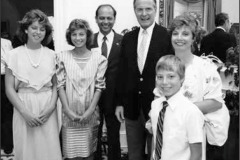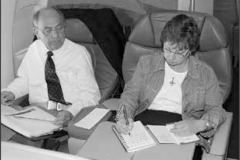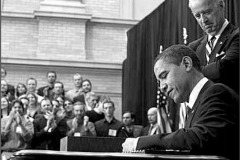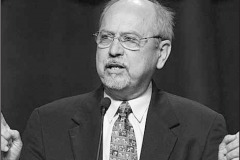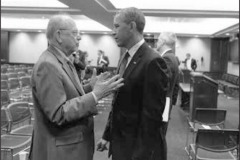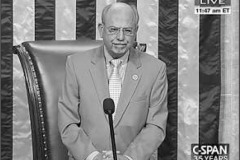Congressman Doc Hastings
Twenty Years of Turmoil
Synopsis

 Congressman Doc Hastings Twenty Years of Turmoil chronicles the life and ten-term congressional career of Richard “Doc” Hastings from his election in 1994 to his decision not to seek re-election in 2014. He served at a time when both the nation and Congress faced domestic and international challenges and a level of political polarization unparalleled in modern times. These divides were the result of many factors, but were compounded by major events that included the 1994 “Republican Revolution,” the Clinton impeachment, 9/11, the ongoing wars in Afghanistan and Iraq, congressional ethics investigations, the Great Recession, Obamacare, the 2012 fiscal cliff, multiple budget crises and government shutdowns. All are described in the book.
Congressman Doc Hastings Twenty Years of Turmoil chronicles the life and ten-term congressional career of Richard “Doc” Hastings from his election in 1994 to his decision not to seek re-election in 2014. He served at a time when both the nation and Congress faced domestic and international challenges and a level of political polarization unparalleled in modern times. These divides were the result of many factors, but were compounded by major events that included the 1994 “Republican Revolution,” the Clinton impeachment, 9/11, the ongoing wars in Afghanistan and Iraq, congressional ethics investigations, the Great Recession, Obamacare, the 2012 fiscal cliff, multiple budget crises and government shutdowns. All are described in the book.
A small-town businessman turned elected representative, Doc Hastings represented his conservative Central Washington district for twenty years. A quiet insider and Republican loyalist, Doc preferred to work behind the scenes as a member of the House Rules, Budget, and the Republican Steering Committee to help shape legislation and public policy to conform to his personal values and conservative political beliefs.
As chairman of the House Ethics Committee he led several high-profile investigations during one of the most contentious periods in recent congressional history. As chairman of the House Natural Resources Committee, he influenced public policy on the environment, energy development, natural resources, and water issues.
Closer to home, he used his influence to create the nuclear cleanup caucus in Congress and insure funding for the Hanford nuclear site, protect the Columbia and Snake River dams, and support water storage solutions for the Yakima River Basin. Because Hastings was rarely in the national spotlight, his detractors often underestimated his accomplishments, but his constituents returned him to office nine times by an average margin of victory of sixty-three percent.
Part biography, part history, and part commentary, Doc is based on the author’s personal interviews and correspondence with more than one hundred different sources, including current and former members of Congress, other elected officials, friends, staff, and associates. It is a “must read” for political junkies and those interested in gaining a better understanding of how our legislative process works.
Fact Sheet
Excerpt
Reviews
Gallery
Fact Sheet
Fact Sheet
| Title | CONGRESSMAN DOC HASTINGS: Twenty Years of Turmoil |
| Author | C. Mark Smith |
| Publication date of print version | April, 2018 |
| Price | $32.95 |
| Publication date of e-book version | April, 2018 |
| Price | $9.99 |
| Marketing Plan |
Personal Appearances, Internet, Social Networking, Historical Societies, Libraries, Educational Institutions
|
| Marketing Contact | Lara Hastings, dochastingsbook@gmail.com |
| Audience/Markets |
History, Politics, Government, Congress, Washington, D.C., Washington State, Central Washington, Yakima, Tri-Cities
|
| Binding |
6 x 9 Full Color Adhesive Hard Cover
|
| Features | Etcetera, Richland, Washington |
| Distributor |
Appendices, Photographs, Endnotes, Bibliography, Index
|
| ISBN print version |
978-1-945271-78-6
|
| ISBN e-book version | 978-1-945271-96-0 |
| LCCN | 2017912638 |
| Pages | 544 |
| Publisher | Book Publishers Network, sheryn@bookpublishersnetwork.com |
| Distributor |
EDK
Distribution, edkbooksanddistribution@gmail.com
|
| Wholesalers |
Baker & Taylor, American West, Readerlink, Quality Books
|
| Website | |
|
|
|
Excerpt
Then it was Tuesday, January 3, 1995, the day of the swearing-in of the 104th Congress. After a reception at the Capitol, the Clerk of the previous Congress called the House to order and asked all members in attendance to acknowledge their presence by inserting their voting cards into the electronic voting machines located throughout the chamber.
After a quorum had been established, the two party conference chairmen nominated their candidates for Speaker of the House. John Boehner of Ohio nominated Newt Gingrich of Georgia. Vic Fazio of California nominated Richard Gephardt of Missouri, the majority leader in the former Congress and now the highest-ranking Democrat after the defeat of the previous Speaker, Tom Foley, for House minority leader. After the nominations were closed, it was time to vote. The Clerk called the Roll of the House members in alphabetical order.
Ms. Harmon. The California Democrat responded, “Mr. Gephardt.”
Mr. Hastert. The future Republican Speaker from Illinois declared, “Mr. Gingrich.”
Mr. Hastings of Florida. “Mr. Gephardt.”
Mr. Hastings of Washington. “Mr. Gingrich.”
As a result of the Republican landslide, the result of the vote was a foregone conclusion. Newt Gingrich was the newly-elected Speaker of the House. The senior member of the Congress, John Dingell of Michigan rose from his accustomed seat in the second row and went to the well to swear in the new Speaker.
At the Speaker’s rostrum Gephardt and Gingrich stood side by side. Grasping the gavel, Gephardt spoke:
. . . So with partnership but with purpose, I pass this great gavel of our government, with resignation but resolve, I hereby end forty years of Democratic rule of this House.
Gingrich then asked the newly elected members to stand, raise their right hand, and affirm the Oath of Office, which he read aloud.
I do solemnly swear that I will support and defend the Constitution of the United States against all enemies, foreign and domestic; that I will bear true faith and allegiance to the same; that I take this obligation freely, without any mental reservation or purpose of evasion, and that I will well and faithfully discharge the duties of the office on which I am about to enter. So help me God.
Richard “Doc” Hastings, the newly elected representative to Congress from Washington’s Fourth Congressional District, responded, “I do.”
As he took in the magnificent scene around him, he looked up at the Speaker’s rostrum and set a personal goal. Someday he would sit there and preside over the Congress as Speaker Pro Tempore, just as he had done when he had served in the Washington State Legislature. As he observed the other members around him and to their friends and families in the packed gallery, he thought, “There are 265 million people in the United States, and only 435 of them are elected to serve in Congress at any one time. I’m one of them. Not too bad for a kid from Pasco.”
Chapter 6, pp._____
―
It was late at night on December 11, 2014. The 113th Congress was getting ready to adjourn. The last vote of the evening was on a motion to suspend the rules and pass the John Muir National Historic Site Expansion Act, sponsored by Doc’s old adversary George Miller of California. By prior agreement, Doc left the dais before the vote was concluded, and another member assumed his place.
Earlier in the evening, Doc had found Speaker John Boehner at his normal place on the left side of the chamber and asked him if he would be hosting members for a glass of wine in his office after the session ended, as was his custom. Boehner answered, “Sure.”
After leaving the dais, Doc walked to the Speaker’s office, where he found the Speaker and several other members conversing about the close of the session and enjoying a glass of wine. As the others left, one by one, it finally became Doc’s turn to say goodbye. He shook Boehner’s hand, left the office, and walked back toward the House Chamber through Statuary Hall, which had been the original House Chamber. Doc was all alone. His footsteps on the marble floor echoed throughout the empty hall. He thought to himself, “You know, I may be walking out of here for the last time.”79
As Doc approached the House Chamber, he made a right, then a left, and then another right, arriving at the elevators, which took him down to the sub-basement of the Capitol. He walked through security to where the tram normally transported members to the Rayburn House Office Building. It was not running that late at night, so he walked through the tunnel to the Rayburn Building basement and into the parking garage where his car was parked. He drove through the dark night across the Potomac River on I-395 to his condominium in Pentagon City.
Several days later, Doc was back home in Pasco.
Chapter 16, pp._____
Reviews
This book about Doc Hastings provides an in-depth look at Congress during the exciting, but difficult years between 1995 and 2015. It describes his many contributions both to the House and to his district during that time.
Although he rarely sought the spotlight, his colleagues considered him a true legislator, who thought government should be the servant of the people, and not its master, and who could be counted on to carry out difficult assignments when asked. That is why he is one of only a handful of members of the House of Representatives to have chaired two standing committees. He was an ally and remains a close friend.
John Boehner
Member of Congress (R – OH) (1995-2015)
Speaker of the House of Representatives (2011-2015)―Doc and I served together for much of our congressional careers and . . . often saw the political turmoil Smith describes from different viewpoints, but his description of it holds true.
Mark Smith has already written excellent biographies of former Tacoma mayor and U.S. Senator Harry Cain and Tri-Cities community icon Sam Volpentest. Now he has written a very readable and interesting biography of former 4th District congressman Doc Hastings and the times in which he served.
Doc and I served together for much of our congressional careers, and while we often disagreed on policy matters, we worked closely together on Hanford and other important statewide issues. We often saw the political turmoil Smith describes from different viewpoints but his description of it holds true.
Norm Dicks
Member of Congress (D-WA) (1977-2013)―Mark Smith’s compelling, insightful biography of Doc Hastings introduces a statewide audience to an under-rated Eastern Washington conservative with a conscience.
Mark Smith’s compelling, insightful biography of Doc Hastings introduces a statewide audience to an under-rated Eastern Washington conservative with a conscience.
John C. Hughes
Legacy Washington Historian
Mark Smith’s new book about Doc Hastings is a welcome addition on two counts.
First, it recognizes the often unappreciated contributions of Doc Hastings, one of our state’s longest-serving congressmen, to his district, his state, his Party, and to his country. Doc and I were close when we served together in Congress. His personal values and his solid, conservative principles drove his politics and he never wavered from either.
Smith’s book also describes the divisive political events that occurred during Doc’s twenty years in Congress. Republican activists entered from stage right. They became the establishment, overreached, struggled to recover, and then were threatened again from the right because they were no longer conservative enough for the next group of activists. The Democratic Party was the mirror image of the process, only from the left.
Smith is a fine storyteller and his book is a valuable primer on how we came to be where we are.
Slade Gorton
US Senator (R-WA) (1981-1987) (1989-2001)
20 years of dams, Hanford and abortion. New book out on Hastings
Matt Taylor
Tri-City Herald
May 7, 2018
During the first of their 20 years in Washington, D.C., Doc and Claire Hastings held quiet holiday parties, serving wines from their home state for staff members of the congressman.
They were happy occasions, and it was the kind of thing that contributed to the reputation of Hastings’ office as a busy but congenial shop.
Eventually, though, the parties moved to restaurants.
Tri-Cities author C. Mark Smith risks a historian’s opinion in his new Hastings biography as to why the shift in locales: Doc’s home had snow white carpeting. Even Washington red wines were a risky delight.
















